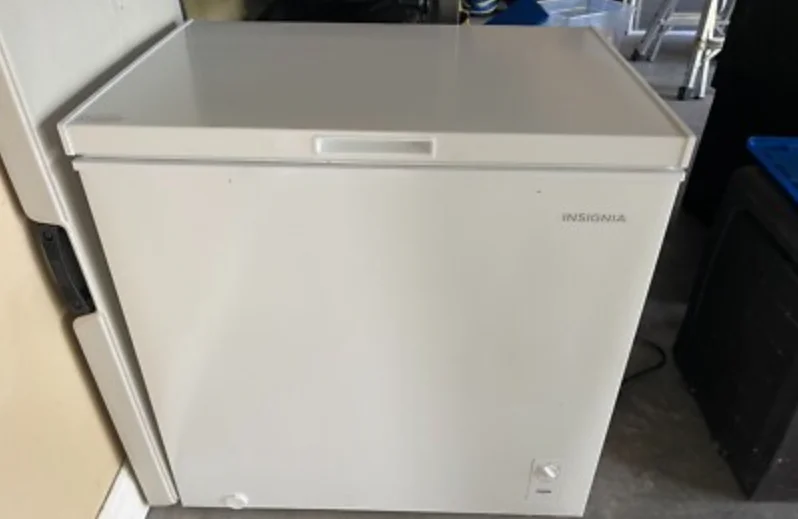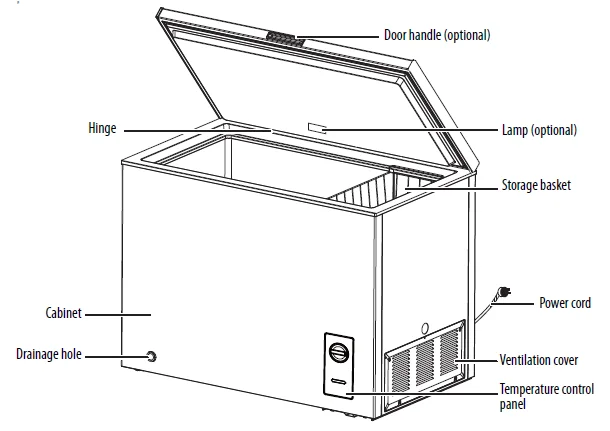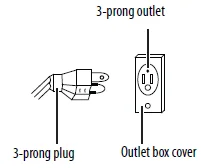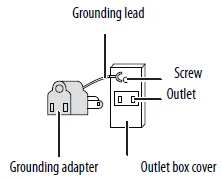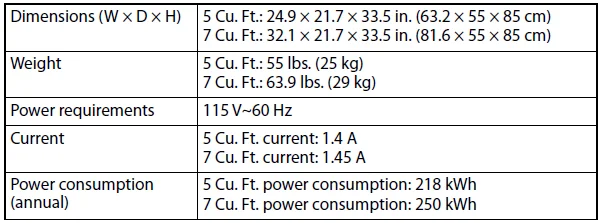![]()
Insignia NS-CZ70WH0 Chest Freezer
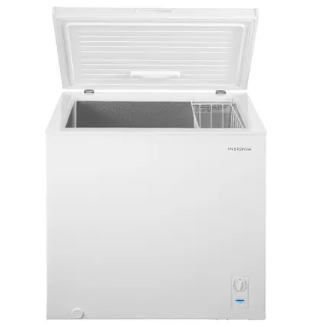
IMPORTANT SAFETY INSTRUCTIONS
WARNING: RISK OF FIRE / FLAMMABLE MATERIALS
- This appliance is intended to be used in household and similar applications such as staff kitchen areas in shops, offices, and other working environments; farm houses and by clients in hotels, motels, and other residential-type environments; bed and breakfast type environments; catering and similar non-retail applications.
- This appliance is not intended for use by persons (including children) with reduced physical, sensory, or mental capabilities, or a lack of experience and knowledge, unless they have been given supervision or instruction concerning use of the appliance by a person responsible for their safety. Children should be supervised to ensure that they do not play with the appliance.
- If the supply cord is damaged, it must be replaced by the manufacturer, its service agent, or similarly qualified persons in order to avoid a hazard.
- Do not store explosive substances, such as aerosol cans with a flammable propellant, in this appliance.
- The appliance has to be unplugged after use and before carrying out user maintenance on the appliance.
- Keep ventilation openings in the appliance enclosure or in the built-in structure, clear of obstruction.
- Do not use mechanical devices or other means to accelerate the defrosting process, other than those recommended by the manufacturer.
- Do not damage the refrigerant circuit.
- Do not use electrical appliances inside the food storage compartments of the appliance, unless they are of the type recommended by the manufacturer.
- Please dispose of the freezer according to local regulations, as it uses flammable blowing gas and refrigerant.
- Do not locate multiple portable socket-outlets or portable power supplies at the rear of the appliance.
- Do not use extension cords or ungrounded (two-prong) adapters.
- The freezer must be disconnected from the source of electrical supply before attempting the installation of any accessory.
- Refrigerant and cyclopentane foaming material used for the appliance are flammable. Therefore, when the appliance is scrapped, it shall be kept away from any fire source and be recovered by a special recovery company with corresponding qualification, other than being disposed of by combustion, so as to prevent damage to the environment or any other harm.
- To avoid a hazard due to the instability of the appliance, it must be fixed in accordance with the instructions.
- Connect to a potable water supply only. (Suitable for ice-making machine).
- To prevent a child from being entrapped, keep out of reach of children and not in the vicinity of the freezer (or refrigerator). (Suitable for products with locks.)
Features
Package contents
- 5 or 7 cubic foot chest freezer
- Storage basket
- Ice shovel (for removing ice buildup inside your freezer)
- User Guide

Setting up your freezer
Before using your freezer
- Remove the exterior and interior packing.
- Let your freezer stand upright for approximately two hours before connecting it to power. This reduces the possibility of a malfunction in the cooling system from incorrect handling of your freezer during transportation.
- Wash the inside with a damp, warm cloth and a baking soda solution (two tablespoons in a quart of water), then wipe dry with a dry cloth. Do this periodically to keep your freezer looking new.
Finding a suitable location
- Your freezer is designed to be free-standing only, and should not be recessed or built-in.
- Place your freezer on a floor that is strong enough to support your freezer when it is fully loaded.
- Allow 6 inches (15 cm) of space between the back and sides of your freezer and any surrounding walls to provide correct air ventilation. Adjust the feet to keep your freezer leveled.
- Locate your freezer away from direct sunlight and sources of heat, such as a stove, heater, or radiator. Direct sunlight may affect the acrylic coating, and heat sources may increase electrical consumption. Extremely cold temperatures may also prevent your freezer from performing correctly.
- Avoid locating your freezer in moist areas.
Providing the correct power supply
Check your local power source. Your freezer requires a 115 V, 60 Hz power supply.
Use a power outlet that accepts the grounding prong. The power cord is equipped with a 3-prong (grounding) plug, which mates with a standard 3-prong (grounding) wall outlet to minimize the possibility of electric shock hazard from your freezer.
Using a 3-prong plug and outlet
Using a grounding adapter
Notes:
- Your freezer should always be plugged into its own individual power outlet, which has a voltage rating that matches the rating plate.
- Never unplug your freezer by pulling on the power cord. Always grip the plug firmly and pull straight out from the outlet.
Using your freezer
The storage life of frozen foods varies, and the recommended storage time should not be exceeded.
Place frozen food into your freezer as quickly as possible after purchase. If there are instructions on the packaging, carefully follow these instructions regarding storage times.
Pre-packed, commercially frozen food should be stored in accordance with the frozen food manufacturer’s instructions for a three-star frozen food storage compartment or home freezer.
A storage basket is provided for the organization of odd-shaped items. To reach other packages in your freezer, just slide the basket to one side or lift it out.
- The first time you turn your freezer on, adjust the temperature control to the setting you want and run it for two to three hours before putting food in.
- After it is fully cooled, adjust the temperature control to the setting that best suits your needs. Settings include MIN, MAX, and OFF.
Notes:
- Turning the temperature control to OFF stops the cooling cycle but does not shut off the power to your freezer.
- If your freezer is unplugged, loses power, or is turned off, you must wait three to five minutes before restarting it. Your freezer will not start if you attempt to restart it too soon.
- Large amounts of food lower the cooling efficiency of your freezer.
- If you choose to change the thermostat setting, adjust the thermostat control by one increment at a time. Allow several hours for the temperature to stabilize between adjustments.
Defrosting your freezer
For your freezer to operate most efficiently and with minimum energy consumption, it should be defrosted when the frost on the freezer walls is in excess of .2 to .4 inches (5 to 10 mm) thick. To minimize food spoilage, choose a time when your stock of frozen food is low.
The instructions regarding the care of frozen foods should be followed when defrosting your freezer. Defrosting usually takes a few hours. Leaving the top open helps speed the process.
CAUTIONS:
- Do not use boiling water to defrost your freezer because it may damage the plastic parts. You can use warm water to speed up the process.
- Never use a sharp or metallic instrument to remove frost, as it may damage the cooling coils and void the warranty.
- Remove the frozen food from your freezer and place it in a refrigerator or cooler to protect the food.
- Turn the thermostat knob to OFF, then unplug your freezer.
- Remove the drain plug inside your freezer, then place a shallow pan under the drainage hole on the outside of your freezer to catch the water from melted ice. Check the pan occasionally to make sure that the water does not overflow.
- When your freezer has defrosted, clean the interior of your freezer, then replace the drain plug.
- Plug your freezer back in.
- Reset the thermostat to the setting you want, then let your freezer cool for one hour.
- Return the food to your freezer.
Maintaining your freezer
Your freezer is designed for year-round use with only minimal cleaning and maintenance. We recommend that you do the following every time you defrost it to keep your freezer running odor-free and efficiently:
CAUTION:
To prevent damage to the finish, do not use:
- Gasoline, benzine, thinner, or other similar solvents.
- Abrasive cleaners.
- Turn off your freezer and unplug it from the wall outlet.
- Remove all food.
- Wash the storage basket with a mild detergent solution.
- Wash the inside with a damp, warm cloth soaked in a solution of one quart of lukewarm water to two tablespoons of baking soda.
- Dry the interior and exterior with a soft cloth.
- Clean the door gasket (seal) to keep your freezer running efficiently.
- Vacuum the condenser coils when they get dusty or dirty.
Storing your freezer
- Turn off your freezer and unplug it from the wall outlet.
- Remove all food.
- Clean your freezer.
- Leave the door open slightly to avoid the possible formation of condensation, mold, or odor.
CAUTION:
Use extreme caution with children. Make sure that children do not play in or near your freezer.
Moving your freezer
- Turn off your freezer and unplug it from the wall outlet.
- Remove all food.
- Securely tape down all loose items inside your freezer.
- Tape the door shut.
- Make sure that your freezer stays in the upright position during transportation.
Tips on saving energy
- Locate your freezer in the coolest area of the room, away from heat-producing appliances or heating ducts and out of the direct sunlight.
- Let hot foods cool to room temperature before placing them in your freezer. Overloading your freezer forces the compressor to run longer. Foods that freeze too slowly may lose quality or spoil.
- Wrap foods correctly and wipe containers dry before placing them in your freezer. This cuts down on frost build-up inside your freezer.
- Do not line the freezer storage basket with aluminum foil, wax paper, or paper towels. Liners interfere with cold air circulation, making your freezer less efficient.
- Organize and label food to reduce door openings and extended searches. Remove as many items as needed at one time, then close the door as soon as possible.
Troubleshooting
CAUTION: Do not try to repair your freezer yourself. Doing so invalidates the warranty.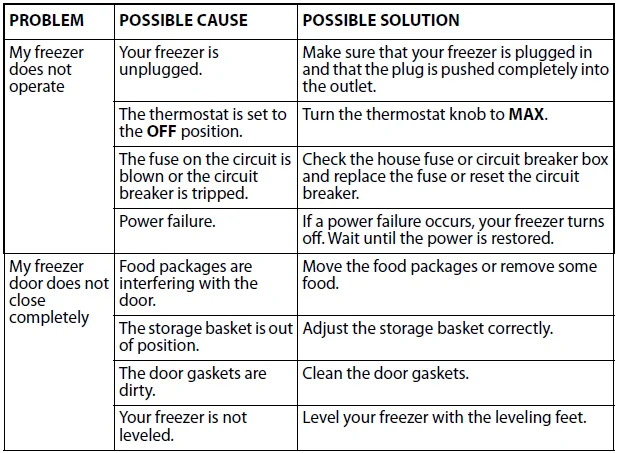
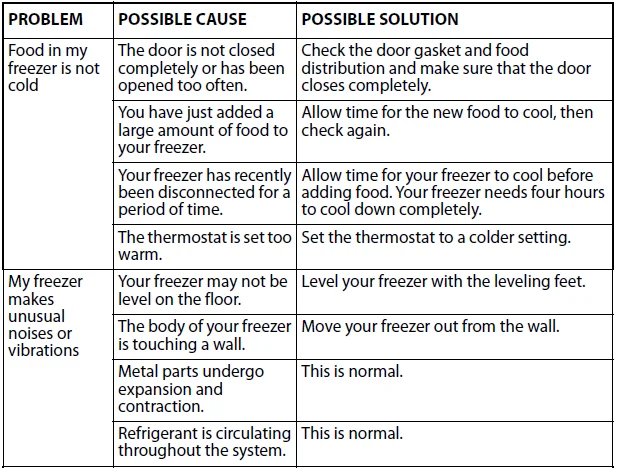
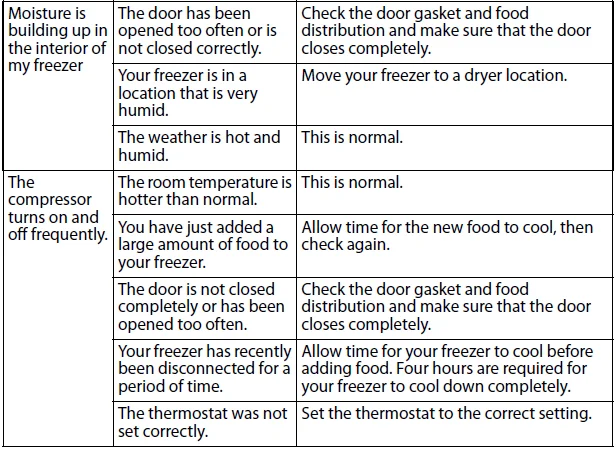
Specifications
Contact Insignia:
- 1-877-467-4289
- www.insigniaproducts.com
For more Manuals by Insignia, visit ManualsLibraryy
Insignia NS-CZ70WH0 Chest Freezer-FAQs
How do I set up and use my Insignia chest freezer?
Plug in the freezer and wait about 30 minutes to ensure it’s cooling properly. To adjust the temperature, press and hold the Lock button for three seconds, then use the + or – buttons to set your desired temperature. A beep will sound when the highest or lowest limit is reached.
What temperature should my Insignia freezer be set to?
For best performance, keep your freezer in a room between 50°F and 85°F (10°C to 29°C). This ensures efficient operation and energy savings.
How long do Insignia chest freezers typically last?
Insignia chest freezers generally last 7–10 years with proper maintenance.
Why is my Insignia freezer not freezing properly?
Possible causes include dirty condenser coils, a faulty compressor, defrost system issues, or damaged door seals. Clean the coils and check seals first before contacting service.
Why did my freezer suddenly stop working?
Common reasons include power supply issues, compressor failure, or a faulty temperature sensor. Ensure the unit is plugged in and check the outlet before scheduling repairs.
How can I reset my freezer or compressor?
Unplug the freezer, turn off the control panel, and wait a few minutes. Plug it back in, then reset the temperature to your preferred setting. Allow time for the freezer to stabilize.
Should my chest freezer run all the time?
Yes, the compressor runs about 80–90% of the time to maintain temperature. This is normal and helps improve energy efficiency.
Can I defrost my freezer using boiling water?
No. Avoid pouring or placing boiling water inside the freezer—it may cause burns or damage the appliance. Use warm water, a fan, or a hairdryer on low heat instead.
How can I defrost my Insignia chest freezer quickly?
Turn off the freezer, remove food, and place bowls of hot (not boiling) water inside. Close the lid to let steam melt the ice faster, or use a fan to circulate warm air.

